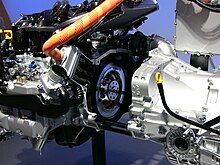| Subaru B5-TPH | |
|---|---|
 B5-TPH displayed at
AMI Leipzig 2006 | |
| Overview | |
| Production | 2005 (concept) |
| Body and chassis | |
| Class | Concept car |
| Body style | 3-door shooting-brake |
| Layout | F4 |
| Powertrain | |
| Engine | 2.0 L EJ turbo-derived |
| Electric motor | 10 kW (13 hp) motor-generator |
| Hybrid drivetrain | Turbo Parallel Hybrid (TPH) |
| Dimensions | |
| Wheelbase | 2,672 mm (105.2 in) |
| Length | 4,465 mm (175.8 in) |
| Width | 1,820 mm (71.7 in) |
| Height | 1,500 mm (59.1 in) |
| Curb weight | 1,385 kg (3,053 lb) |
The Subaru B5-TPH was a concept shooting-brake coupe with a Turbo Parallel Hybrid (TPH) powertrain made by Fuji Heavy Industries (FHI), introduced at the 2005 Tokyo Motor Show. [1]
Design

The concept behind the B5-TPH was to design a car "for long-weekend [getaways] for couples." [2] Contemporary news articles were generally supportive of the new design direction, [3] [4] which anonymous sources claimed would be used in a forthcoming Impreza. [5] Subaru stated the next Impreza would not be based on the B5-TPH's styling, and that they would launch a hybrid vehicle based on the B5-TPH powertrain in Japan by 2007. [3] [6]
Technical

The TPH drivetrain featured an electric motor-generator sandwiched between the gasoline motor, which used the Miller cycle, and the automatic transmission. The electric motor was intended to reduce turbo lag and boost fuel economy, with an estimated consumption of 40 mpg‑US (5.9 L/100 km; 48 mpg‑imp) on the EPA combined city/highway cycle. [7] The B5-TPH used manganese lithium-ion batteries. [7] [8]
The gasoline engine had an output of 191 kW (256 hp) at 6,000 RPM and 343 N⋅m (253 ft⋅lb) of torque at 2,400 RPM. The electric motor had outputs of 10 kW (13 hp) and 150 N⋅m (111 ft⋅lb) of torque. [9]
The TPH system was developed with the intent of mass production. Subaru's prior concept hybrid, the B9 Scrambler, featured a Sequential Series Hybrid Electric Vehicle (SSHEV) powertrain. In the SSHEV design, the electric motor was used as the sole source of propulsion up to 80 km/h (50 mi/h), switching over to the gasoline engine above those speeds. [10] The newer TPH system was more cost-effective because it used a more compact electric motor and battery. [11]
The batteries were developed by NEC Lamilion Energy, Ltd., which had been co-founded in 2002 by NEC and FHI to develop a lithium-ion capacitor which promised better energy density and durability compared to normal storage batteries. [11] NEC Lamilion was later absorbed into Automotive Energy Supply Corporation, who would go on to supply the lithium-ion battery pack for the Nissan Leaf electric vehicle. [12]
References
- ^ Aziz, Nick (20 October 2005). "Subaru B5-TPH concept". Left Lane News. Retrieved 26 May 2017.
- ^ "Exhibition outlines of the 39th Tokyo Motor Show 2005" (PDF) (Press release). Subaru Corporation. 28 September 2005. Retrieved 2 June 2017.
- ^ a b "Subaru B5-TPH Concept". Automobile. 1 February 2006. Retrieved 2 June 2017.
- ^ Murphey, Paula (October 2006). "Dream Cars". Boys' Life. Vol. XCVI, no. 10. Irving, Texas: Boy Scouts of America. p. 21. ISSN 0006-8608. Retrieved 2 June 2017.
- ^ "Subaru hybrid hints at next Impreza". Autocar. 4 October 2005. Retrieved 2 June 2017.
- ^ Zoia, David E. (10 January 2006). "Subaru Forecasts Another Year of Growth; Hybrid Coming". Ward's Auto. Retrieved 2 June 2017.
- ^ a b "Subaru Hybrid Concept Vehicle Makes North American Debut; New Technologies Point to Brand's Hybrid Strategy - Company continues "green" efforts to help safeguard the environment" (Press release). Detroit, Michigan: Subaru. 9 January 2006. Retrieved 26 May 2017.
- ^ "Subaru Hybrid Electric Vehicles and the Quest for Electric Power". Drive. Subaru. Winter 2006. Archived from the original on 26 May 2017. Retrieved 26 May 2017.
- ^ Pettendy, Marton (5 October 2005). "First look: Subaru enters hybrid race". GoAuto. Retrieved 30 May 2017.
- ^ Visnic, Bill (4 January 2004). "Curvy Subaru B9SC Roadster Hides Advanced Hybrid Power". Ward's Auto. Retrieved 30 May 2017.
- ^ a b "Fuji Heavy Industries Announces Its Development of the Turbo Parallel Hybrid and Lithium-Ion Capacitor Technologies" (Press release). Subaru Corporation. 18 August 2005. Retrieved 31 May 2017.
- ^ "The history of AESC". Automotive Energy Supply Corporation. 2016. Retrieved 31 May 2017.
External links
- "Subaru B5-TPH". Diseno-Art. Retrieved 25 May 2017.